
Sky Meadows State Park is a 1,862-acre (754 ha) park in the Virginia state park system. In addition to preserved woodland, meadow and swamp, sections of the park are farmed, in part because it contains the former Mt. Bleak-Skye Farm which was listed on the National Register of Historic Places in 2004. Located in extreme northwest Fauquier County, Virginia in the Blue Ridge Mountains, near Paris, Virginia off U.S. 17, one mile (1.6 km) south of U.S. 50 and seven miles (11 km) north of Interstate 66, it is an International Dark Sky Park located about an hour outside the Washington, D.C. metro region.

Advance Mills, also known as Fray's Mill, is an unincorporated community in Albemarle County, Virginia.
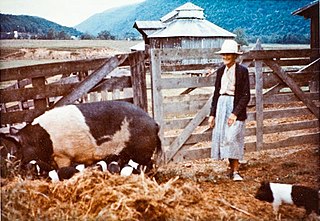
The Kuykendall Polygonal Barn was an early 20th-century polygonal barn in the South Branch Potomac River valley near Romney in Hampshire County, West Virginia, United States. The Kuykendall Polygonal Barn was the only 15-sided barn built in West Virginia, and one of only a few such known to have been constructed in the United States. The barn utilized a number of sophisticated technological innovations not found in West Virginia's other round and polygonal barns. The Kuykendall Polygonal Barn was listed on the National Register of Historic Places on 9 July 1985.

This is a list of the National Register of Historic Places listings in Hampshire County, West Virginia.
Beardslee Farm is a national historic district and farmstead located at Pittsfield in Otsego County, New York. It encompasses five contributing buildings, one contributing site, and one contributing structure. It consists of the farmhouse, dependencies, and a small family cemetery. The L-shaped farmhouse is a large sprawling wood frame residence comprising three sections that reflects three separate building campaigns, c. 1790, c. 1800, and c. 1810. The main section is a two-story, five-bay building with a center entrance and a gable roof. Also on the property is a horse barn, carriage house, corn house, hop barn, and pump house.

The Boyd–Wilson Farm is a 157-acre (64 ha) historic district in Franklin, Tennessee, United States. The circa 1840 farm includes an I-house.

Maidstone Manor Farm, also known as William R. Leigh House, is a national historic district located near Hedgesville, Berkeley County, West Virginia. It encompasses a historic farm with three contributing buildings and one contributing site, the site of a slave cabin. The plantation house is a two-story, square brick dwelling with a slate covered pyramidal roof. It is three bays wide and two bays deep and features a one bay entrance portico supported by paired Doric order columns. Also on the property are a barn and brick smokehouse. It was the birthplace of noted artist William Robinson Leigh (1866-1955), father of William Colston Leigh, Sr. (1901-1992).

North River Mills Historic District is a national historic district located at North River Mills, Hampshire County, West Virginia. The district encompasses 25 contributing buildings and five contributing sites. The district lies along Hiett Run, which empties into the North River, a tributary of the Cacapon River. It has become an industrial ghost town, now visited only by summer residents and tourists. The contributing buildings include the Hiett House with shed and privy; Croston House and barn ; North River Mills Grocery ; Shanholtz House, also known as North River Mills Society for Antiquarian Arts and the Diffusion of Knowledge; North River Mills School ; Miller House and associated outbuildings; United Methodist Church ; Kump House ; and the Moreland House. Contributing sites are the cemetery associated with the Kump House, Miller Mill Site, Shanholtz Mill Site, mill pond, and millrace.
"Maplewood", also known as Sebrell-McCausland Farm, is a historic home and national historic district located near Pliny, Mason County, West Virginia. The district includes eight contributing buildings and four contributing sites. The main house is a two-story Italianate-style brick farmhouse with wood siding. It features two round attic portholes and three porches. Also on the property are the following contributing buildings / sites: a coal house, chicken house, blacksmith shop, and well house all built about 1870; the Jenny Lind House ; a schoolhouse / storage shed ; machine shed ; the ruins of the main barn and hog barn ; and the Sebrell-McCausland Cemetery and Slave Cemetery, both established about 1850.
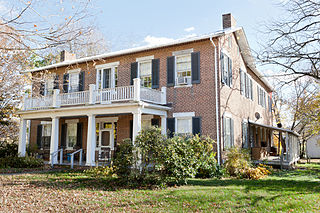
Fort Hill, also known as Fort Hill Farm, is a historic plantation house and national historic district located near Burlington, Mineral County, West Virginia. The district includes 15 contributing buildings, 1 contributing site, and 2 contributing structures. The main house was completed in 1853, and is a two-story, L-shaped brick dwelling composed of a side-gable-roofed, five-bay building with a rear extension in the Federal style. It features a three-bay, one-story front porch supported by 4 one-foot-square Tuscan order columns. Also on the property are a number of contributing buildings including a washhouse and cellar, outhouse, a dairy and ice house, a meat house, a garage, a hog house, poultry houses, a bank barn with silo, and a well. The family cemetery is across the road west of the main house. Located nearby and in the district is "Woodside," a schoolhouse built about 1890, and a tenant house and summer kitchen.
Nickell Homestead and Mill, also known as Mont Glenn Farm, is a historic home, grist mill, and national historic district located at Secondcreek, near Ronceverte, Monroe County, West Virginia. The district includes seven contributing buildings. The original section of the main house was built about 1820, with additions made in 1858, and about 1900. It is a 2+1⁄2-story, six bay brick and frame Federal style dwelling. The 1900 addition has some Colonial Revival style details. Also on the property is a two-story mill built in 1814, a barn, machine shed, hog shed, garage, and house by the mill. The Nickell mill closed in 1949. The property upon which the mill stood was sold in 2014 or 2015. The new owner tore down the mill. The only thing remaining is the stone foundation. The new owner is not maintaining the property and the house is also falling into disrepair. One wonders why this person bought an historic property only to destroy it.

Pickaway Rural Historic District is a national historic district located at Pickaway, near Union, West Virginia, Monroe County, West Virginia. The district includes 126 contributing buildings, 1 contributing sites, and 7 contributing structures centered on Pickaway and surrounding rural areas. Notable properties in the core include the Reverend John Simpson House (1840), Pickaway School (1890), Trinity Methodist Episcopal South Church (1887), Pickaway Store and Post Office, and frame mill and blacksmith shop. Surrounding farms included in the district are the Gilchrist-Pritt-Perrine farms; Overholt-Gilcrist-Pritt and McClung farms; Beckett, Kilcollin, and Lemon farms; and Siebold and Weikle farms.
The Camp Bartow Historic District — centered on the historic inn called "Traveller's Repose" and the site of the Battle of Greenbrier River (1861) — is a national historic district located at Bartow, Pocahontas County, West Virginia, United States. It is situated at the foot of Burner Mountain, at a bend in the East Fork Greenbrier River, where U.S. Route 28 intersects U.S. Route 250.

Henderson Hall Historic District is a National Register of Historic Places (NRHP)-listed historic district in Boaz, Wood County, West Virginia. The primary contributing property is Henderson Hall, a home in the Italianate style from the first half of the 19th century. Other residences at the site are a tenant house from the end of the 19th century, and "Woodhaven", the 1877 home of Henry Clay Henderson. Additional structures include a smokehouse, two corn cribs, a carriage barn that also served as a schoolhouse, a scale house used for storing agricultural equipment, and two barns. Also included within the district are the 19th-century Henderson family cemetery, a wall, a mounting block, and three mounds associated with the pre-Columbian Adena culture.
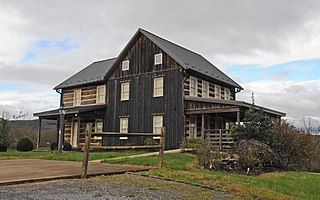
Rock Hill Farm, also known as the Davis-Stauffer Farm Complex, is an historic, American home and farm and national historic district located in Montgomery Township in Franklin County, Pennsylvania.

Longwood is a historic home and farm located near Earlysville, Albemarle County, Virginia. The house was built about 1790, with additions between 1810 and 1820, and about 1940. It is a two-story, five-bay frame building with a two-story store/post office addition and a small one-story, two-bay, gable-roofed frame wing. It has Federal and Colonial Revival design elements. Also on the property are a contributing frame barn, a frame schoolhouse for African American students [c. 1900), a late-19th-century stone well, and the 19th-century cemetery of the Michie family.

Rochambeau Farm is a historic home and farm complex located near Manakin-Sabot, Goochland County, Virginia. The main dwelling was built about 1855, and is an L-shaped full two-story frame structure set on a common bond brick foundation in the Greek Revival style. It has a low hip roof and three single-story colonnade porches.

Sunray Agricultural Historic District is a national historic district located at Chesapeake, Virginia. The district encompasses 188 contributing buildings, 90 contributing sites, 2 contributing structures, and 1 contributing object in the early 20th-century immigrant farming community of Sunray. It includes early 20th century vernacular farmhouses, agricultural buildings, Sunray School (1922), and St. Mary's Catholic Church (1915-1916). The district also includes a tidal ditch system, the abandoned Virginian Railway Tracks (1909), and agricultural fields laid out with the platting of 1908.
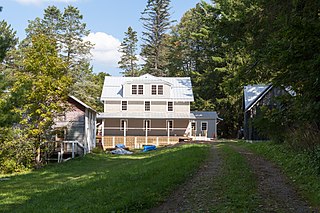
Brookside Historic District is a national historic district located at Aurora, Preston County, West Virginia. It encompasses 11 contributing buildings, 1 contributing structure, and 1 contributing site in the small community of Aurora. There are five properties included: Brookside Inn/Gaymont, the Brookside Cottages, Cathedral State Park, Brookside Farm, and the Red Horse Tavern (1825). The community was an important example of a turn-of-the-20th century rural retreat with farm. Owners of the resort took advantage of its location close to the Baltimore and Ohio Railroad and created a respite from the city heat for residents of Washington, Baltimore, Cleveland and other cities.
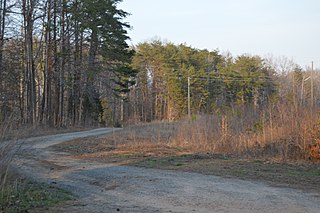
The Collins Ferry Historic District encompasses two historic farmsteads, as well as a mill and ferry site on the Staunton River in rural northern Halifax County, Virginia, west of Brookneal. The district covers 768 acres (311 ha), extending south from the river roughly to Bull Creek Road, and westward from the mouth of Buffalo Creek, which roughly bisects the district. The Collins Farm, which is located at the end of McKeever's Trail, includes one of Halifax County's best-preserved Federal style plantation houses, built c. 1810 and located on a bluff overlooking the creek. The Collins Farm includes 19th century farm outbuildings, the family cemetery, a mill site along the river, and the site where stones for the mill's construction and grinding stones were quarried. The Hubbard Farm is located south and east of the Collins Farm, and is accessed via a private drive that forms part of the historic road leading to Collins Ferry. Hubbard Farm includes a Greek Revival farmhouse built in 1856, and also includes 19th century outbuildings, a family cemetery, and the remains of a slave quarters.



















